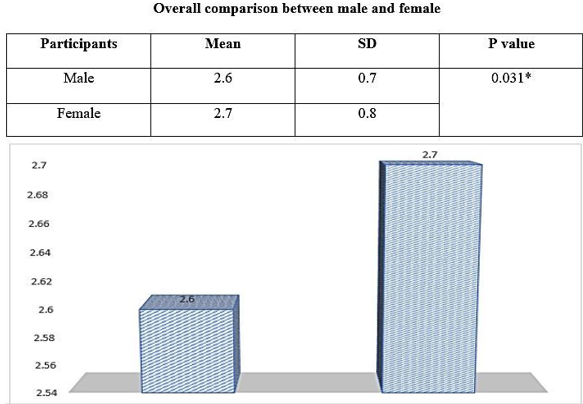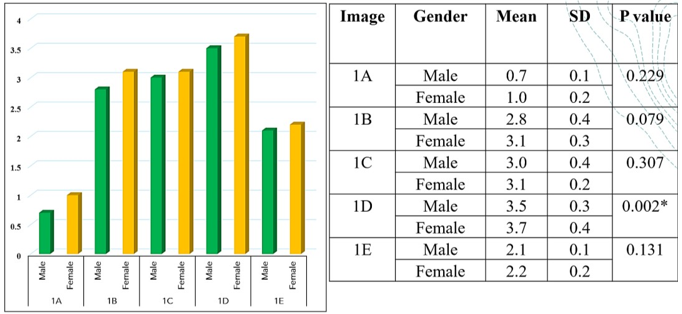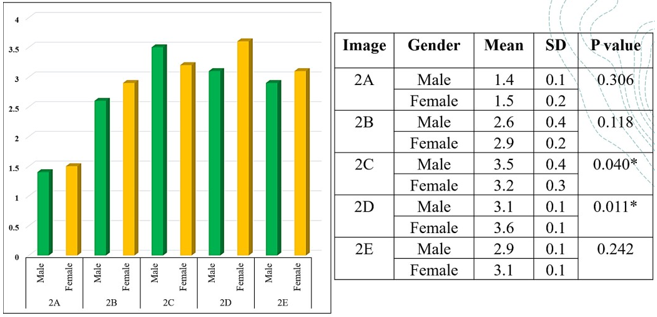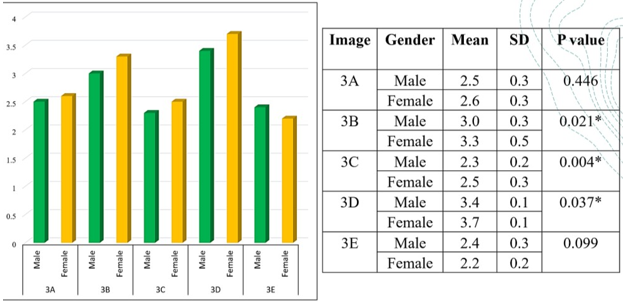Introduction
The concept of beauty is wide and individual; therefore, the assessment of beauty is extremely subjective. Esthetics play a substantial role in people’s lives, and facial appearance has a deep influence on personal attractiveness and self-esteem. The human face is considered the most important individual factor concerning attractiveness.1 The criteria to determine the esthetics as acceptable or unacceptable varies according to social and cultural values, and this standard has changed across history.2 It is important to understand that the perception of dentofacial esthetics should consider the esthetic parameters of the patients and the society in which they belong.3, 4 This appreciation of beauty is also influenced by individual factors, such as sex, ethnicity, education, and the influence of marketing and media. 5, 6
In recent years, increased emphasis has been placed on esthetics in dentistry.7 The quest for excellent dentofacial esthetics is a reality in contemporary society. 8 There is evidence to support the notion that the aesthetics of the mouth has a significant effect on the way we develop a first impression of another person. 9 Social attractiveness is influenced by a variety of different smile-related factors, hence the smile is one of the most essential human facial expressions that enhance the reward value of an attractive face. In esthetic viewpoint, the profile and frontal views of the same smile were not rated similarly; the former was rated higher than the later. 10 Labio-lingual inclination of the maxillary incisors also plays a major role in profile smile attractiveness. Facial profile disharmonies in the antero-posterior (AP) position of the mandible are among the most frequent reasons that patients seek orthodontic treatment. 11
Aim
To evaluate the esthetic effects of maxillary incisor inclination with regard to different mandibular position in male and female subject’s smile profile.
Objectives
To determine the preferred tooth position in the smile profile of subject with regard to different mandibular positions in male and female and to elucidate whether the profession and sex played a role in the assessment of the preferred maxillary incisor inclination in growing and non-growing individual.
Materials and Method
Exclusion criteria
Presence of midline diastema or spacing in the anterior segment.
Presence of crowding in the anterior segment.
Excessive gingival display during smiling.
Increased buccal corridor.
Acute and chronic periodontal disease, gingival recession.
Presence of caries, trauma, restoration and prosthesis in the anterior teeth.
A right lateral profile and frontal view photographs with the patient in natural head position with white background at a distance of 1.5 m from the camera were taken. The first image was taken with a neutral facial expression. The second image was taken with the subject in a posed smile. Smile parameters will be evaluated and recorded. These smiling photographs were altered using a commercially available image editing software program (Adobe Photoshop CS, version 8.0; Adobe Systems).
The photographs were divided into 3 profiles.
In the next step, each profile group was further divided into 5 subgroups based on tooth position. The number of photographs that were available after altering the above-mentioned parameters is 15 for each subject, in total 30 photographs for each rater. Each series of images were printed separately on Digital Printing Paper with a Photo Smart printer in a 15x20cm format and then was placed randomly in a binder. The rating panel comprised 100-200 raters including orthodontists and laypersons. Each judge was given a set of profile photographs to rate the attractiveness of each photograph. All raters were asked to evaluate the profile images of each set to score them from 1 to 5:
Statistical analysis
Table 1
Each profile with its corresponding mandibular position and labiolingual inclination of maxillary incisors
Figure 1
Three sets of altered images with different mandibular positions and maxillary incisors inclination in female.
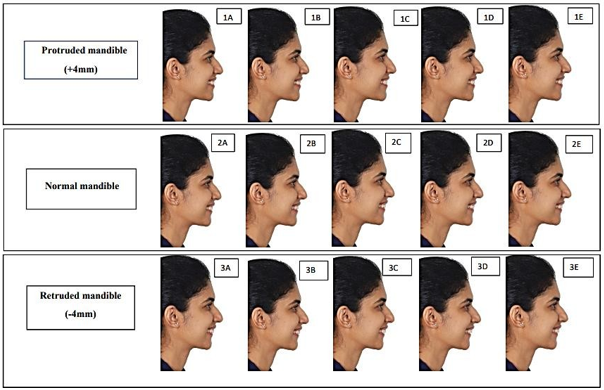
Figure 2
Three sets of altered images with different mandibular positions and maxillary incisors inclination in male.
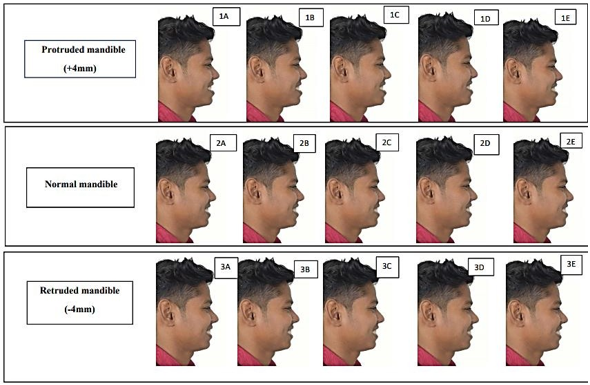
Result
One hundred sixty-two assessors participated in this study. The statical analysis showed there was significant difference.
Comparison between male and female, female rated high mean of 2.7+/- 0.8 with significant difference P>0.031.
Comparison between the responses on male and female subjects in the first set which is protruded mandible, it was found that ID has significant difference with P=0.002. (Figure 3 ), Where in female 1D rated most pleasant profile with the mean value of 3.7+/-0.4 rated high.
Comparison between the responses on male and female subjects in the second set which is normal mandible, it was found that 2C, 2D have significant difference with P=0.040 & P=0.011 respectively. (Figure 5), Where in Male 2C rated most pleasant profile with the mean value of 3.5+/-0.4 rated higher than female with the mean value 3.2+/-0.3.
Female rated most pleasant profile in 2D with mean value of 3.6+/-0.1 than male with mean value of 3.1+/-0.1.
Comparison between the responses on male and female subjects in the third set which is retruded mandible, it was found that 3B, 3C & 3D have significant difference with P=0.021, P=0.004 & P=0.037 respectively. (Figure 6), Where in female 3D rated most pleasant profile with the mean value of 3.7+/-0.1 rated higher than male with mean value of 3.4+/-0.1.
Discussion
Esthetically pleasing faces generally have good proportions, facial balance, and harmony, and yet differences often emerge in the interpretation of these concepts.12, 13, 14 Smile attractiveness is a multifactorial process that can easily be achieved by proper positioning of the maxillary incisors. Both the inclination and the bodily position of these teeth should be favorable to ensure maximum facial harmony. In this study, we developed a series of facial profile photographs based on the original ideal profile of growing and non growing subjects to be evaluated by different groups of orthodontists, dental professionals and lay people. By altering the mandibular position and the maxillary incisor inclination in the smiling profiles, we tried to determine the most desirable and the least favorable of the forementioned combinations as a whole and to elucidate whether the mandibular position and the rater's professions are the key factors in ranking the preferred incisor inclination.
There were significant differences between the male and female subjects’ perception of facial profiles and dental esthetics. A straight profile was preferred in male subjects, and a mild convex profile was preferred in the female subjects. (Figure 4, Figure 5, Figure 6).
People who subscribe to traditional sex stereotypes tend to assume that women with a mild convex profile are more beautiful, kind, naïve, and weak, and less socially dominant. By contrast, people tend to see men as more firm, alert, strong, and coordinated. Many studies have suggested that masculinity and femininity are significantly shaped by culture. 15, 16
In the study of Ghaleb et al, dentists, orthodontists, and laypeople preferred an increase of 50 in a labial direction in the smiling profile; this agrees with the ratings of the orthodontic and other panel members in our study. On the other hand, photographs with 100 and 150 of lingual inclination had the lowest scores in all panels in the study of Ghaleb et al; this is comparable to the results of our study panels. For the extreme lingual inclinations (150 and 100), the orthodontists gave significantly lower scores than did the dentists and laypeople. The image with the 150 labial inclination was deemed esthetically acceptable only by the orthodontists. These results agree with our study in which the panel members gave the lowest scores to the extreme lingual inclination. 17
In our study inclination of maxillary teeth rated differently in all three sets of photographs. Labial inclination of 50 higher than the lingual inclination. Lingual and labial inclination with 100 rated low in both subjects.
Conclusion
In this study women with a mild convex profile are more beautiful and men with straight profile consider to be esthetically more pleasant and the effects of mandibular position on the preferred incisor inclination was assessed, labial inclination was considered as attractive as compared with lingual inclination; In a patient with mandibular deficiency where camouflage treatment is indicated, a lingual inclination of the maxillary incisor can compromise esthetics and should be avoided by maintaining appropriate torque during incisor retraction.

